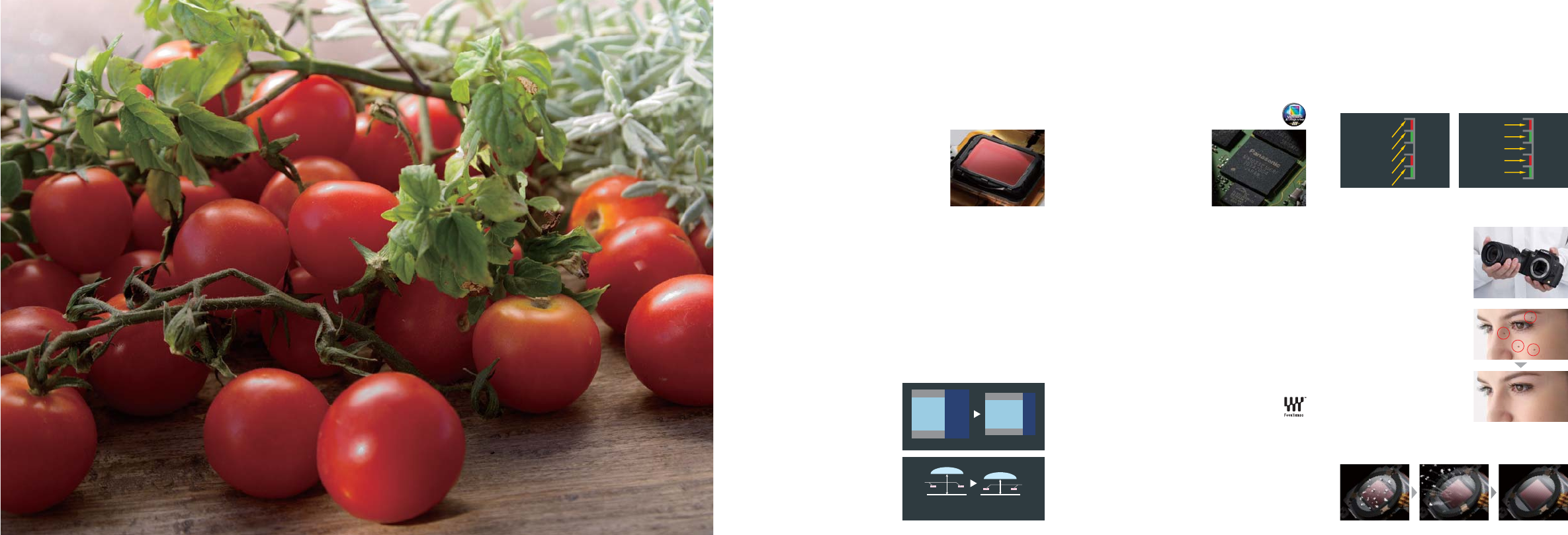
7.5 megapixels 10.1 megapixels
Circuit section
Circuit section
Wiring
Light receiving
area
Wiring
Wiring
Light receiving
area
Wiring
Microlens
Photodiode
Wiring
Photodiode
Microlens
Wiring
7.5 megapixels 10.1 megapixels
08 09
LEICA D VARIO-ELMAR 14-50mm/F3.8-5.6 ASPH. /MEGA O.I.S. 1/80 sec, F6.3, ISO100
Light rays
(Image)
Image
sensor
(Image)
Image
sensor
Light rays
Film camera lens design. FourThirds System lens design.
A High-Performance Digital SLR Changes Your View
10.1-Megapixel 4/3-Type Live MOS Sensor
The Rich Tonal Quality of a CCD
Sensor Plus the Low Power
Consumption of a CMOS Sensor
At the heart of the L10 is a
sophisticated 10.1-megapixel
4/3-type Live MOS sensor. Drawing
on MOS signal amplification
technology but using a simpler structure, this advanced sensor
combines the superb image quality of a CCD sensor with the
low power consumption of a CMOS sensor. It's molded as a
single unit onto a flexible circuit board, so both the number
of signal exchanges and the contact resistance from wiring
are reduced. Also, an advanced process technology with low-
voltage drive reduces heat and noise while improving the
image quality provided by the Live View function.
10.1-Megapixel Resolution
with Low Noise and High Sensitivity
Thanks to state-of-the art circuit downsizing technology, the
light-receiving area of the L10's 10.1-megapixel Live MOS
sensor is about the same size as that in a 7.5-megapixel
sensor. This helps prevent the noise that would result
from reducing the
pixel size. Also, the
distance from the
microlens to the
photodiode has been
shortened, so light-
collecting efficiency
is improved. This
gives the L10 a level
of sensitivity that
equals or surpasses
7.5-megapixel sensors.
High-Performance Venus Engine III LSI
High-Resolution Images with
Well-Reproduced Color
and Low Noise
The Venus Engine III image
processor was developed to
maximize the performance of the
Leica D lens and Live MOS sensor.
In addition to helping achieve outstanding resolution, superb
color and detailed gradation, this advanced LSI distinguishes
chromatic noise from luminance noise and reduces the
chromatic noise – one of the main causes of image quality
degradation. This helps the L10 deliver the exceptional image
rendering performance one expects from a quality SLR camera.
Quick Response and Low Power Consumption
The super-fast Venus Engine III helps give the L10 a quick
startup, short shutter interval, and solid consecutive shooting
performance. This combines with the Live MOS sensor's
low energy consumption to give the L10 a longer battery life.
Even with its many advanced functions, the L10 lets you take
around 450 shots (CIPA standard) on a single battery charge.
Four Thirds™ Standard: Designed
for the Digital Camera
For a digital SLR camera to capture an image accurately, the
light must strike the image sensor at a perpendicular angle. But
with fi lm camera lenses, light from the image edges enters at
a non-perpendicular angle. The result can be inaccurate color-
reproduction or dark areas. The L10 uses a lens mount that has
about twice the diameter of the image circle. This allows light to
strike the sensor at a virtually perpendicular angle, so images
are clear and accurate all the way to the edges.
*Four Thirds is a registered trademark of Olympus Optical Co., Ltd.
Dust Reduction System Protects the Image Sensor
One risk with conventional digital
SLR cameras is that as you change
the lens, dust can enter the camera
and stick to the image sensor. This
would show up as a fl aw in the same
location on every photo you shoot.
Even worse, the foreign matter
could damage the image sensor.
The L10 solves this problem with
a dust reduction system. A special
Supersonic Wave Filter is positioned
in front of the image sensor. Every
time you turn the camera on, the
filter vibrates perpendicularly
around 30,000 times a second,
creating a wave-like motion across
the entire filter to shake loose any
dust particles clinging to the filter. This system even shakes
loose and captures particles that would not be loosened by the
horizontal movement of the image sensors in some cameras.










